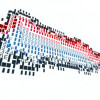How Will We Keep Supercomputing Super?
Cray’s Jaguar supercomputer is the fastest machine on the planet, according to the Top 500 list of supercomputers published today by four researchers in the computing industry. It marks the first time that Jaguar beat out IBM’s Roadrunner on a performance basis, achieving 2.3 petaflops, or about 2 million billion calculations a second. However, a deeper look at the list shows that the trend in supercomputing is not only one of faster machines, but a steady erosion of how super supercomputing actually is, as exemplified by dedicated vendors such as SiCortex being shut down and venerable players like SGI filing for bankruptcy before then getting acquired.
Increasingly, many of the parts that make up a supercomputer — from the types of processors used to the networking cables — are the same as those used in everyday corporate computing. As the chart makes clear, the number of different processors used to build supercomputers has been shrinking. This is partly due to Moore’s Law, which enables the x86 architecture (the same type of chips inside your computer) to make steady performance gains, but is also a function of how cheap mass-produced chips are. And because most supercomputers are built for the government, getting as many flops for the dollar is essential. Even on the networking side, Ethernet is making strides when compared to more expensive, proprietary networking technologies such as Infiniband.









































































